Both active and passive fire protection measures are required in numerous buildings—and one affects the other
There are two types of fire protection in structures: active and passive. Active fire protection refers to fire protection elements and systems that require some action in order to function. These include fire sprinkler systems, fire alarm systems, mechanical smoke evacuation systems, and fire extinguishers. Passive fire protection—fire compartmentation in buildings—refers to structures that are built into a building to passively prevent or stop the spread of smoke and fire. These include components such as smoke dampers, fire-rated walls, and fire doors.
Current fire protection, life safety, and building codes require building compartmentation features that vary based on occupancy type. Both a fire compartment and a smoke compartment are defined by NFPA 101: Life Safety Code as “a space within a building that is enclosed by fire or smoke barriers on all sides, including the top and bottom” (3.3.49.1 and 3.3.49.2)—and they are often required:
From the 2018 edition of NFPA 101
8.2.2.1 Where required by other chapters of this Code, every building shall be divided into compartments to limit the spread of fire and restrict the movement of smoke.
Where exactly is passive fire protection required?
Occupancy types that specifically require fire compartmentation in buildings include educational occupancies, hospitals, detention and correctional facilities, and hotels, dormitories, and apartment buildings. Additional areas that are commonly required to be protected by fire-rated construction within various occupancies include stairwells, corridors, and hazardous locations (such as electrical rooms). The occupancy-specific sections of code will determine the minimum fire-resistance rating that is required for each area.
The International Building Code (IBC) specifies the requirements for different occupancy types in individual chapters governing the type. Each one points back to Chapter 7, which outlines the overall construction requirements and features for various fire-resistance-rated building components. There are similar construction requirements and features in Chapter 8 of NFPA 101.
Compartments are constructed of fire-resistance-rated materials and assemblies which are tested and approved by ASTM International, formerly known as American Society for Testing and Materials. ASTM E 119: Standard Test Methods for Fire Tests of Building Construction and Materials outlines the requirements that must be met and the testing that must be performed to give a specified building component its fire rating.
These fire-resistance-rated walls and barriers can be rated for the following time periods which indicate how long they survive according to standard fire tests:
- 3 hour
- 2 hour
- 1 hour
- ½ hour
Note that these ratings are the result of testing conditions; their actual performance in an emergency may vary depending on the unique conditions of a building and a fire.
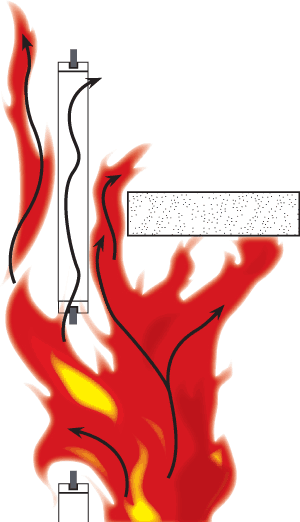
Fire compartmentation in buildings: How to protect openings in a fire-rated wall
In order to effectively resist the effects of fire, heat, and smoke, a fire-rated barrier must be complete and whole. There cannot be any openings or holes in the wall such as open doors, windows, or holes for wires, cable, ductwork, or pipe. Each of these openings within a fire-resistance-rated component must be safeguarded with “opening protectives.”
From the 2018 edition of NFPA 101
8.3.3 Opening Protectives
8.3.3.1 General. Every opening in a fire barrier shall be protected to limit the spread of fire from one side of the fire barrier to the other.
From the 2018 edition of the IBC
706.8 Openings. Each opening through a fire wall shall be protected in accordance with Section 716 …
When openings are needed in a fire-resistance-rated component, they must be properly rated for the fire-resistance rating of the wall. For example, if a door is needed in a 3-hour fire-resistance-rated wall, the door also must have a 3-hour fire-resistance rating. If a properly rated fire door is not installed, then the fire-resistance rating of the entire compartment is no longer valid.
When holes must be punched through a fire-rated assembly for necessary building components such as wiring, duct work, cables, or pipes, this is referred to as a “penetration” that must be protected by a “firestop system or device:”
From the 2018 edition of NFPA 101
8.3.4 Penetrations.
8.3.4.2 Firestop Systems and Devices Required.
8.3.4.2.1 Penetrations for cables, cable trays, conduits, pipes, tubes, combustion vents and exhaust vents, wires, and similar items to accommodate electrical, mechanical, plumbing, and communications systems that pass through a wall, floor, or floor/ceiling assembly constructed as a fire barrier shall be protected by a firestop system or device.
From the 2018 edition of the IBC
706.9 Penetrations. Penetrations of fire walls shall comply with Section 714.
714.2 Installation. A listed penetration firestop system shall be installed in accordance with the manufacturer’s installation instructions and the listing criteria.
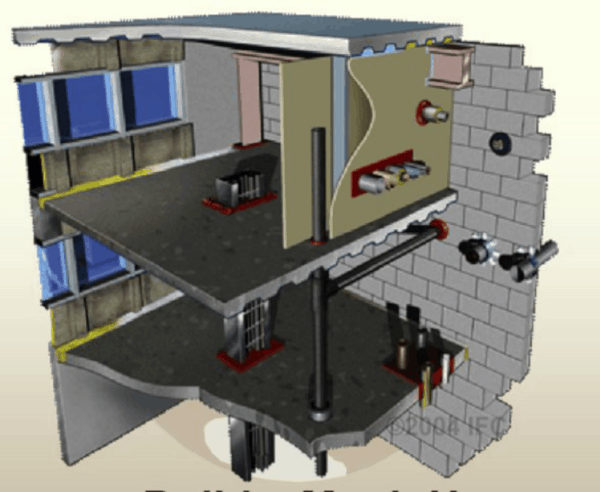
This firestop system or device must be “listed” and “labeled” for use as such and, just as with opening protectives, it must be rated to match the fire-resistance rating of the wall or another surface that is being penetrated.
From the 2018 edition of NFPA 101
3.2.4 Labeled. Equipment or materials to which has been attached a label, symbol, or other identifying mark of an organization that is acceptable to the authority having jurisdiction and concerned with product evaluation, that maintains periodic inspection of production of labeled equipment or materials, and by whose labeling the manufacturer indicates compliance with appropriate standards or performance in a specified manner.
3.2.5 Listed. Equipment, materials, or services included in a list published by an organization that is acceptable to the authority having jurisdiction and concerned with evaluation of products or services, that maintains periodic inspection of production of listed equipment or materials or periodic evaluation of services, and whose listing states that either the equipment, material, or service meets appropriate designated standards or has been tested and found suitable for a specified purpose.
Selecting a penetration firestop system to maintain fire compartmentation in buildings
Appropriate products are tested for their effectiveness and rated based on the test requirements of ASTM E814: Standard Test Method for Fire Tests of Penetration Firestop Systems. Though there are some firestop products, such as caulking, that are available from big-box home-improvement stores, those are often intended for residential use and do not meet the requirements for commercial buildings.
Additionally, the effectiveness of a firestop product is based on using the proper product for the right application, as well as the proper installation of the item. For this reason, it is recommended that a contracting company specializing in firestop applications be utilized for new construction, renovations, or repairs. These professionals will only use products that are labeled and listed for a specific application and will be well-versed in installing them properly.
To select the proper firestop system, there are several pieces of information that must be known:
- Assembly type. What type of construction is being penetrated? Is it a wall, floor, or ceiling? Is it constructed of concrete, wood, or other material?
- Penetrating item. What kind of item is being pushed through the wall? Is it electrical cabling, a metal pipe, a plastic pipe, an air duct, or a combination of items?
- Required rating. What is the fire-resistance rating of the assembly being penetrated?
These ratings are listed on the products as “F” ratings and “T” ratings. The F rating refers to the amount of time that it will take for a fire to break through from the exposed side to the non-exposed side of the fire-rated wall or assembly. The T rating refers to the time it takes for the penetrating item to heat to 325 degrees F plus ambient temperature. NFPA 101 requires that each of these ratings be no less than 1 hour and, again, they must at least match the rating of the barriers that protect the overall compartment:
From the 2018 edition of NFPA 101
8.3.4.2.3 F Ratings. Firestop systems and devices shall have an F rating of not less than 1 hour, and not less than the required fire resistance rating of the fire barrier being penetrated.
8.3.4.2.4. T Ratings.
8.3.4.2.4.1 Penetrations in fire resistance-rated horizontal assemblies shall have a T rating of not less than 1 hour, and not less than the fire resistance rating of the horizontal assembly.
UL (formerly Underwriters Laboratories) is the most prominent agency for the listing and labeling of these products. UL has a user-friendly web tool that can assist building owners and facility managers in selecting and installing the correct firestop product or system.
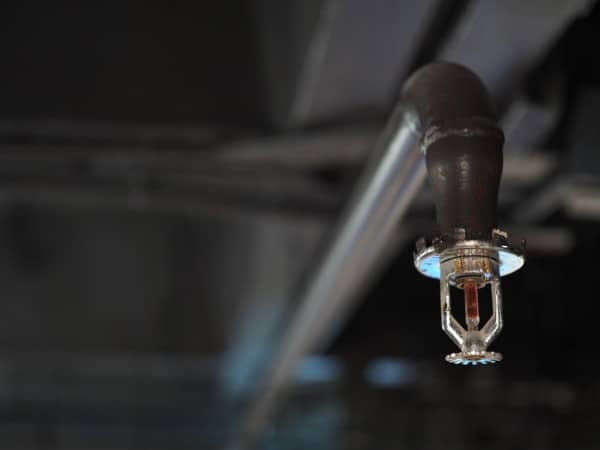
Does penetrating fire sprinkler piping need to be firestopped?
You might think that fire sprinkler pipes would be exempt from the requirements of fire-stopping penetrations given that they deliver water to extinguish fires. However, this is not the case. Fire sprinkler piping is indeed required to be firestopped where it penetrates a fire-resistance-rated barrier.
The above code references from the IBC and NFPA 101 require that all penetrations through fire-rated barriers are protected. Further guidance for multi-story buildings is provided in NFPA 13: Standard for the Installation of Sprinkler Systems:
From the 2019 edition of NFPA 13
9.2.1.15.2 In buildings having more than a single story, pipe penetrations at each floor shall be firestopped using materials equivalent to the floor construction.
However, there are two notable exceptions outlined in both NFPA 13 and the IBC, both of which basically outline that firestopping is not necessary when it will impair the ability of fire sprinklers to operate:
From the 2019 edition of NFPA 13
16.2.5.4 The use of caulking or glue to seal the penetration or to affix the components of a recessed escutcheon or concealed cover plate shall not be permitted.
From the 2018 edition of the IBC
714.4.2 Membrane Penetrations. Membrane penetrations shall comply with 714.4.1. Where walls or partitions are required to have a fire-resistance rating, recessed fixtures shall be installed such that the required fire resistance will not be reduced.
Exceptions:
(5) The annular space created by the penetration of an automatic sprinkler, provided that it is covered by a metal escutcheon plate.
A “through penetration” is an opening for sprinkler piping that is going through the entire wall or another barrier. A “membrane penetration” is an opening through only one section of the barrier, such as the drywall on one side of the ceiling or wall. The term “annular space” refers to the distance between the outside edge of the penetrating item and the inside edge of the barrier opening.
The above exceptions apply to the sprinkler head component extending through the ceiling (for pendent sprinklers) or wall (for sidewall sprinklers). This is because some movement of the head must be allowed for. Metal escutcheon plates are required because they prevent fire, heat, and smoke from extending behind the sprinkler head and into the next space. And cover plates cannot be permanently adhered with firestop components, as this would prevent operation of the sprinkler.
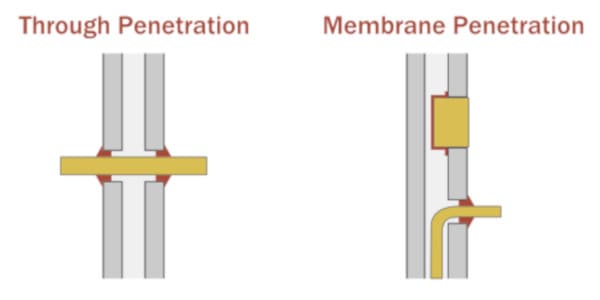
Fire protection features must function as part of a total system
The terrorist attacks on September 11, 2001 spurred a great deal of analysis of emergency preparedness across various disciplines, including fire protection. One of these efforts was an investigation and subsequent report on the life safety systems in 7 World Trade Center (7 WTC), which collapsed nearly seven hours after Towers 1 and 2. Authored by the National Institute of Standards and Technology (NIST), a leading organization in the investigation of disasters, explosions, and building collapses, the 2008 report describes the sequence of events, what fire protection elements were in place at the time, and the factors that could mitigate a collapse in the future.
Though passive fire resistance features such as fire-rated walls were in place at 7 WTC, the NIST investigation found that “improved compartmentation in tenant areas” would limit the spread of future fires in other buildings. It also emphasized that the redundancy of fire protection systems is critical to structural integrity:
“The passive fire protection system (including … compartmentation and firestopping) and the active sprinkler system each provide redundancy for maintaining structural integrity in a building fire, should one of the systems fail to perform its intended function.”
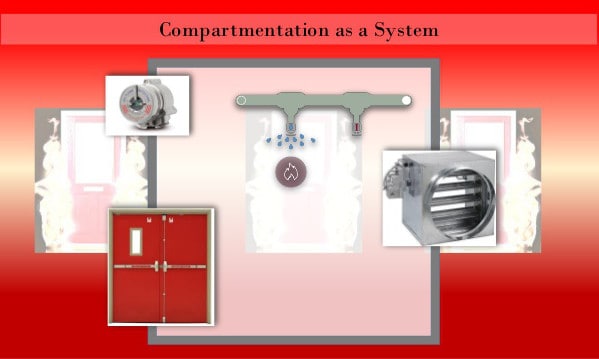
To be most effective, fire protection features must work as a part of a total system, not a stand-alone function. This requires that both active and passive fire protection features be properly installed and integrated within a structure.
Without proper fire-resistance-rated construction and equivalent protection of penetrations, a fire would potentially be able to grow uncontained and quickly exceed the effectiveness and limits of the fire sprinkler system. And without functioning sprinklers, a fire may spread and grow to overwhelm the passive fire protection components, whatever their rating.
Active and passive fire protection measures work together to prevent the catastrophic loss of life and property.
If you are looking to by fire protection system components or tools, browse QRFS’s wide selection, including fire extinguishers, sprinkler pipe components and pipe-hanging accessories, valves, standpipe and FDC components, sprinkler heads, testing and monitoring tools, and more.
If you have questions or need help finding an item, call us at +1 (888) 361-6662 or email support@qrfs.com.
This blog was originally posted at blog.qrfs.com. Check us out at Facebook.com/QuickResponseFireSupply or on Twitter @QuickResponseFS.



1. What NFPA code talks about fire compartmentation?
2. What firewall rate for MDB rooms is recommended in NFPA?
More than one NFPA document may refer to passive fire protection measures, including compartmentation, but you are chiefly looking for NFPA 101. Regarding “MDB rooms:” not 100% sure what you are referring to, though probably using the term regarding electrical distribution facilities. You should contact a qualified fire protection professional to assess your specific structure and its needs, as navigating compartmentation can be fairly complex, especially since the rules may change based on the size of a facility, the nature of a facility, and the presence of other fire protection systems.
fire compartment & smoke compartment in a hospital is the same thing? and There is no specification indicating the area requirements for fire compartments?
Vinny — The concept can refer to both. For example, this is from NFPA 101: Life Safety Code (2024 edition):
Hope that helps and thanks for reading!